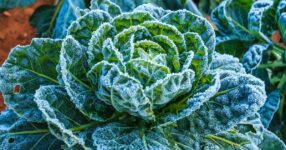
Gardening after the first fall frost
There is nothing worse than frost in the forecast and a garden full of vegetables not quite ready for picking. Use some simple strategies to extend the growing season and keep enjoying garden-fresh vegetables.
Fortunately, some vegetables like cabbage, broccoli, cauliflower, kale and Brussels sprouts tolerate frost and even taste better after a slight chill. Most of these can tolerate temperatures as low as 24 to 28 degrees Fahrenheit.
Leeks are another vegetable that thrives in cooler temperatures. Many tolerate temperatures as low as 20 degrees Fahrenheit. Just mound some protective mulch around the plants and continue harvesting.
Leave some of your carrots, turnips and parsnips in the ground for winter. Just cover the soil with straw or evergreen boughs after it lightly freezes. Dig as needed or during a winter thaw. You will enjoy their wonderfully sweet flavor.
Protect frost-sensitive plants with old bedsheets and even mattress pads. Cover the plants in the late afternoon and remove them as soon as the temperatures climb above freezing. Keep them handy and be ready to cover whenever frost is in the forecast.
Make it easier by using all-purpose garden fabric row covers. This spun material allows air, light and water through while protecting the plants from frost.
Loosely cover the plants and anchor the edges with stones, boards or garden pins. You only need to remove the fabric to harvest ripe vegetables. Otherwise, it can stay in place until the vegetables stop producing or you decide it is time to end the season.
Create a high tunnel over garden beds filled with large plants. Use hoops and row covers to allow easy access for harvesting while protecting the plants. Systems like Maxi Garden Hoops stand 7 feet tall and 5 feet wide when installed. Simply cover the set of three hoops with row cover fabric.
Cloches have long been used to jump-start the season or extend it beyond the first fall frost. You will find a variety of shapes and sizes available. Select one large enough to cover your plants and protect them as needed. Look for those with vents to prevent plants from overheating and ones like the cool weather row cloches (gardeners.com) that allow water through while trapping in the heat.
Don’t let unripe tomatoes go to waste if you are unable or unwilling to protect them from frost. Harvest any that are starting to show color before the killing frost and finish ripening them indoors. The bottom of the tomato should be greenish-white or starting to color up. Store your green tomatoes in a cool (60 to 65 degrees) location to extend their storage life.
Spread the tomatoes out on heavy paper or wrap them individually in newspaper so the fruit does not touch. They will ripen over the next few weeks. Speed up the process by moving a few tomatoes to a warm, bright location a few days before they are needed. Enjoy green tomatoes fried, in relish, salsa, pies or one of many more ways.
And when the season finally ends for you, start planning for next year. Many of these same strategies can be used to jump-start the season for an earlier harvest.



